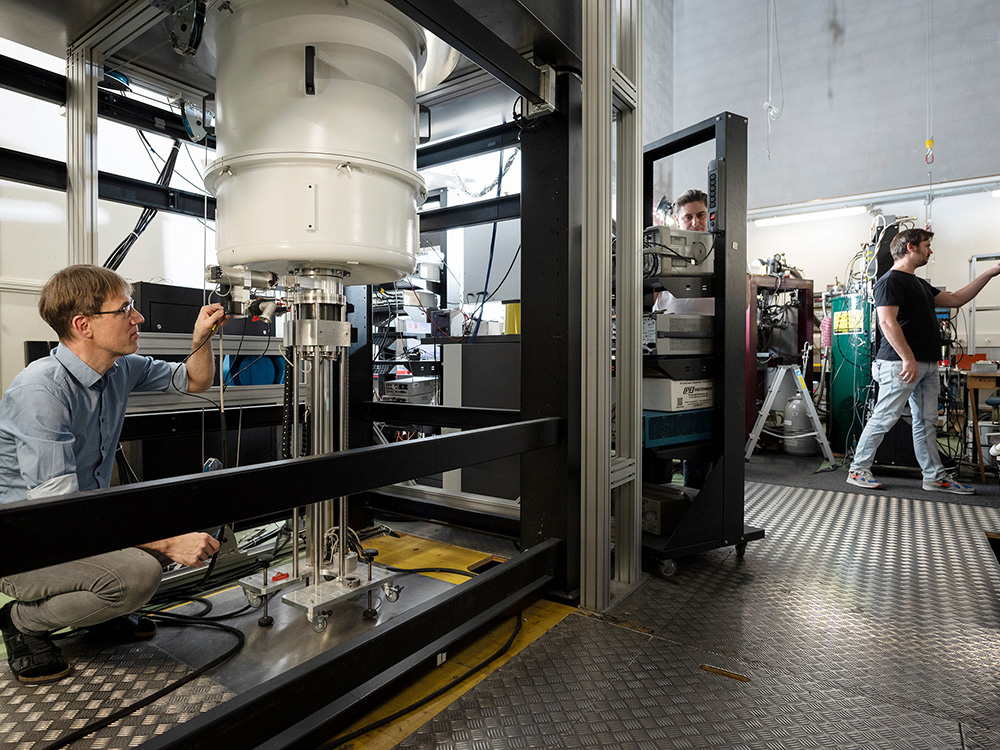Quantum Computer Revolution
The Qubit, like the transistor, will revolutionize our society. Nobody knows exactly when, but Dominik Zumbühl is convinced the time is approaching. He and his research group are working on producing stable and scalable qubits. These qubits will enable the quantum computer to achieve a computing power many times greater than that of today's supercomputers.
Dominik Zumbühl is fascinated by physics, driven by the urge to discover and understand the inner workings of nature: «Already as a child, I wanted to know how electronic devices work, particularly computers,» he says. In high school, a physics teacher took notice of his passion and encouraged him to pursue his interests. This led to Dominik Zumbühl being so familiar with computers that he was engaged as a substitute teacher while still a high school student.
Experiments at ultra-low temperatures
After his studies at ETH Zurich, Dominik Zumbühl lived in the US for several years. He obtained his PhD at Stanford and Harvard Universities before he returned to Switzerland in 2006 as an assistant professor at the Department of Physics at the University of Basel. Here he established the Quantum Coherence Laboratory, which today explores low-temperature electronics experiments to study quantum physics in semiconductor nanostructures.
Dominik Zumbühl became Professor of Experimental Physics in 2012, since 2021 he is Director of the NCCR SPIN, a national research focus funded by the Swiss National Science Foundation. The goal of NCCR SPIN is to develop stable and scalable qubits, tiny computational units that can be interconnected by the thousands and millions to form the basis of a quantum computer. With his team he is working towards building the individual quantum bits or qubits for short.
How does this work? «In addition to its mass and electric charge, each electron has a small magnetic field,» Dominik Zumbühl explains. «This magnetic field or 'spin' can be imagined of as an arrow that is able to point in any direction in space. If the arrow points up, it corresponds to a logical 1, if it points down, it corresponds to a 0.» While a conventional bit can only be 1 or 0, the spin can point not only up or down, but in any other direction in space, thanks to the laws of quantum physics. As a result, the qubit – the basic information unit of quantum computing – can store a much larger amount of information than a bit of today's computers, operating according to the laws of classical physics, which has only two possible positions available.
Sensitive qubits
Compared to conventional bits, quantum bits (qubits) are much more susceptible to interference and tend to lose their information content very quickly. Computing with quanta therefore faces the difficulty of keeping the sensitive qubits stable over time while finding ways to perform fast quantum operations.
In 2021, the Zumbühl research group, together with researchers at TU Eindhoven, succeeded in realizing a novel qubit which has a stable but slow state suitable for storing quantum information. Using a change in electrical voltage, the researchers were able to switch the qubit to a much faster but less stable manipulation mode. In this state, the qubits can be used to process information rapidly.
«The spin can be coherently rotated from top to bottom in just one nanosecond,» says Dominik Zumbühl. «That allows for almost a billion operations per second which brings spin qubit technology closer to the clock speeds of today's conventional computers.»
Getting the spins in semiconductor nanostructures under control is at the heart of current research. The concept goes back to a 1998 paper by David DiVincenzo (Forschungszentrum Jülich) and Daniel Loss, who is also at the University of Basel.
Teamwork for a promising future
A quantum computer will accomplish within minutes calculations, which would take thousands of years with today's computers. It’s evident where a quantum computer will be of use in the future: With its enormous computing power, it will equally be able to solve complex logistics problems and calculate optimal routes and sequences as it can speed up the search for new active ingredients in medical research. «We have the chance to lay the foundations for a new Silicon Valley,» Dominik Zumbühl is convinced.
Research is still in its infancy: «Although we have produced the first qubits, we need to direct our future research in many directions, to exhaust and refine the spins, and to thoroughly understand the physics of these structures.»
Dominik Zumbühl understands his job as a team sport: «I don't do research alone,» he notes. «I am fascinated by physics and want to infect my students with the physics virus. I’m driven by the fascination of investigating new phenomena and this fascination keeps me going even when things get tough.» He conveys passion for physics not only in the lecture hall, but also in the laboratory, at schools or even sometimes in the theater – to make sure there will be plenty of future researchers to achieve the goal of a quantum computer.
Quantum computers – supercomputers of the future
Since February 2021, Zumbühl is director of the National Center of Competence in Research (NCCR) SPIN: Spin Qubits in Silicon. The NCCR aims to advance the research and development of future quantum computers and enable the construction of a universally usable quantum computer using silicon-based qubits. Research groups from the University of Basel, IBM Research Zurich, ETH Zurich and EPF Lausanne are involved in the project. The Swiss National Science Foundation (SNSF) is supporting the NCCR with 17 million Swiss francs in the first funding phase from 2020 to 2023.



